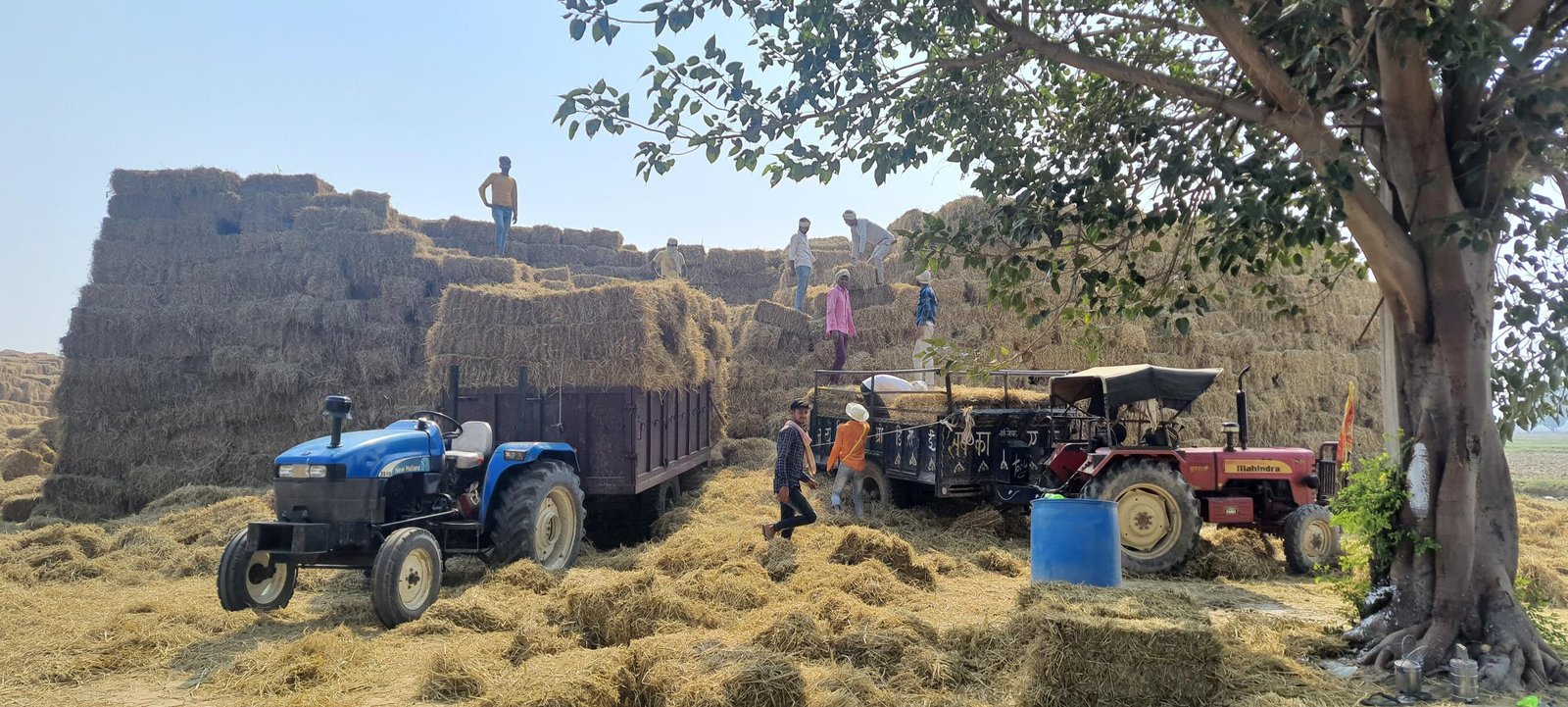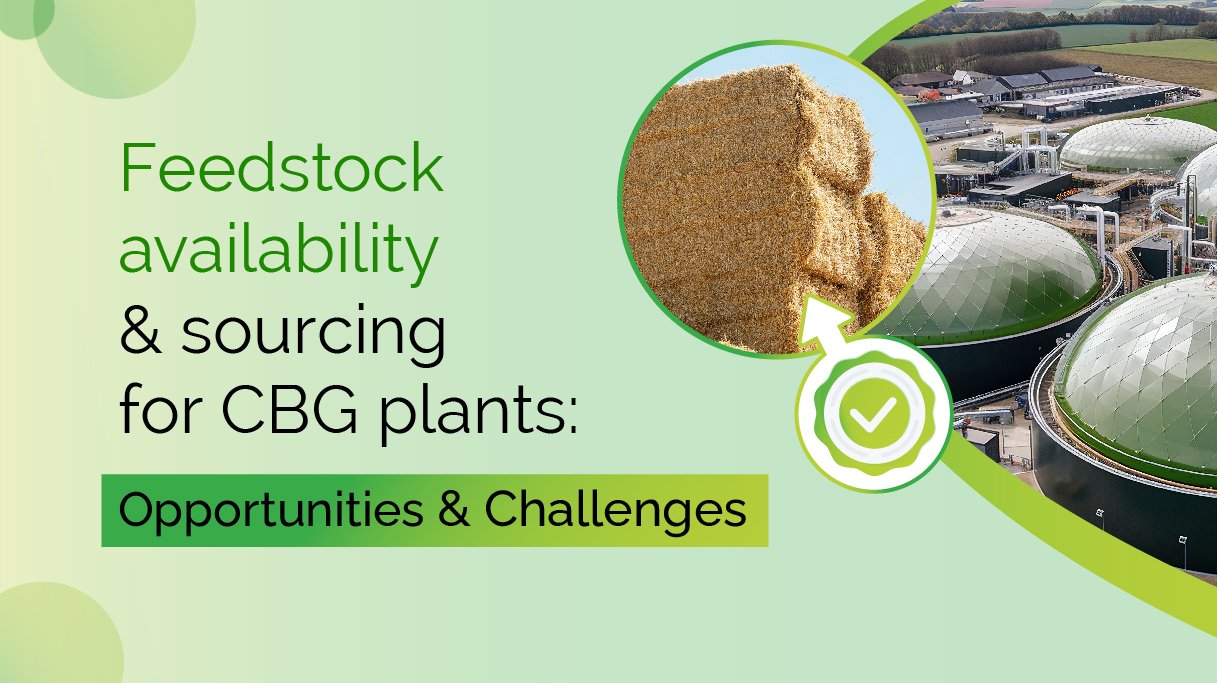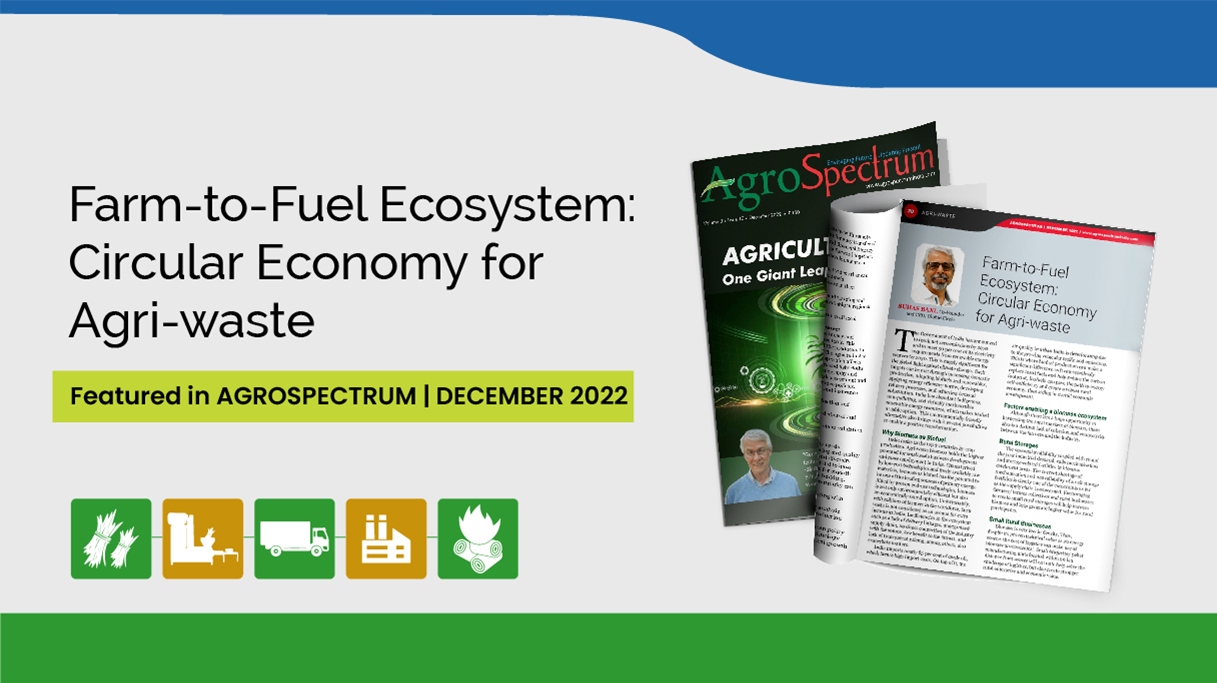 August 21, 2024
August 21, 2024
Over the past few years, compressed biogas (CBG) has emerged as a viable alternative to imported fossil natural gas, offering nearly net-zero emissions and enhancing energy security. Various waste and biomass sources, such as cattle dung, agricultural waste, distillery spent wash, press mud, organic fraction of municipal solid waste, and sewage treatment plant sludge, undergo decomposition to produce biogas. However, feedstock sourcing for CBG plants in India presents unique challenges due to the country's diverse agricultural landscape, infrastructure constraints, and socio-economic conditions.
Problems in Sourcing Biomass
 Consistency and Quality Issues: The primary hurdle is ensuring a consistent and reliable biomass supply throughout the year. This consistency must be maintained not only in supply but also in the quality of the biomass. Agricultural residues, which are a common feedstock for CBG, are often seasonal and can lead to supply shortages during off-seasons.
Feedstocks such as crop residues and animal manure might be diverted for other purposes like animal feed or organic fertilizers, leading to competition and limited availability for biogas production.
The quality and composition of organic feedstocks can vary significantly, affecting the efficiency and yield of biogas production. Feedstocks may contain impurities or contaminants such as plastics, stones, or heavy metals, which can impede the digestion process and damage equipment. Proper segregation is difficult and expensive, and non-segregated waste leads to lower gas yields.
Logistics and Transportation: Gathering feedstock from dispersed locations and transporting it to the CBG plant can be costly and logistically complex. Some organic feedstocks are perishable and must be processed quickly to avoid degradation, adding to logistical challenges. Therefore, machinery tailored for specific crop residue types, including slashers, rakers, and balers to chop, aggregate, and bale stubble into a transport-ready form, is required.
Consistency and Quality Issues: The primary hurdle is ensuring a consistent and reliable biomass supply throughout the year. This consistency must be maintained not only in supply but also in the quality of the biomass. Agricultural residues, which are a common feedstock for CBG, are often seasonal and can lead to supply shortages during off-seasons.
Feedstocks such as crop residues and animal manure might be diverted for other purposes like animal feed or organic fertilizers, leading to competition and limited availability for biogas production.
The quality and composition of organic feedstocks can vary significantly, affecting the efficiency and yield of biogas production. Feedstocks may contain impurities or contaminants such as plastics, stones, or heavy metals, which can impede the digestion process and damage equipment. Proper segregation is difficult and expensive, and non-segregated waste leads to lower gas yields.
Logistics and Transportation: Gathering feedstock from dispersed locations and transporting it to the CBG plant can be costly and logistically complex. Some organic feedstocks are perishable and must be processed quickly to avoid degradation, adding to logistical challenges. Therefore, machinery tailored for specific crop residue types, including slashers, rakers, and balers to chop, aggregate, and bale stubble into a transport-ready form, is required.
 Storage Issues: Infrastructure and storage are yet another challenge. Adequate storage facilities are necessary to handle and store feedstocks, particularly when dealing with large volumes of perishable materials. Substantial investments are needed for proper storage of feedstock and to prevent the seepage of leachate. Moreover, advanced pre-treatment technologies are often required to process feedstocks effectively, and the lack of such technologies can hinder efficient biogas production.
Technological Constraints: CBG production predominantly relies on five distinct feedstocks: animal waste, agricultural residue, press mud, organic waste from municipalities, and Napier grass. Currently, most plants in India utilize single-source feedstocks due to the absence of economically viable mixed feedstock processing technology. Accessible technology for handling mixed feedstocks would enable plants to utilize a variety of sources, mitigating concerns regarding sourcing and shortages. Additionally, economic factors also play a role. Feedstock prices can be volatile and influenced by seasonal changes, market demand, and other factors, affecting the financial viability of CBG plants. For example, fluctuations in oil prices can impact the cost of transporting feedstock.
Solutions to Address Feedstock Sourcing Challenges
Storage Issues: Infrastructure and storage are yet another challenge. Adequate storage facilities are necessary to handle and store feedstocks, particularly when dealing with large volumes of perishable materials. Substantial investments are needed for proper storage of feedstock and to prevent the seepage of leachate. Moreover, advanced pre-treatment technologies are often required to process feedstocks effectively, and the lack of such technologies can hinder efficient biogas production.
Technological Constraints: CBG production predominantly relies on five distinct feedstocks: animal waste, agricultural residue, press mud, organic waste from municipalities, and Napier grass. Currently, most plants in India utilize single-source feedstocks due to the absence of economically viable mixed feedstock processing technology. Accessible technology for handling mixed feedstocks would enable plants to utilize a variety of sources, mitigating concerns regarding sourcing and shortages. Additionally, economic factors also play a role. Feedstock prices can be volatile and influenced by seasonal changes, market demand, and other factors, affecting the financial viability of CBG plants. For example, fluctuations in oil prices can impact the cost of transporting feedstock.
Solutions to Address Feedstock Sourcing Challenges
 The biofuel sector, especially CBG, has gained significant support through initiatives like SATAT. As the industry grows, it's crucial to encourage small and medium enterprises to participate. Local biomass-driven facilities can make biofuel production feasible for smaller businesses, promoting a diverse and resilient industry. Exploring distribution pathways and local usage is also essential, as there are two main distribution routes for CBG: local production and use, particularly in rural areas, which can create a circular economy, cut transportation costs, and boost sustainability; and a central pathway involving building strong distribution networks for broader reach. Both routes have challenges, but local use cases might be easier to start with.
Additionally, creating a robust supply chain involves harnessing food waste and other types of organic waste and channelling it economically to production facilities to ensure a steady supply of biomass and biofuel.
Furthermore, the government needs to foster collaboration among industry stakeholders, academia, and research institutions. By establishing forums for exchanging information and collaborating on projects, we can spur innovation and address the obstacles facing the biofuel industry. Increasing public awareness of the environmental and economic advantages of biofuels can accelerate market acceptance and assist in achieving the government's sustainability objectives.
Overcoming these challenges requires a combination of technological innovation, effective logistics, supportive policies, and collaboration among various stakeholders. For instance, BiofuelCircle’s cloud-based digital platform ensures a consistent and reliable biomass supply through its Biomass Banks™, which are responsible for the collection, transportation, and storage of biomass, creating a robust and reliable supply network for biofuels.
Developing integrated supply chains, investing in advanced pre-treatment and storage technologies, and fostering community engagement are critical steps toward ensuring a reliable and sustainable feedstock supply for CBG plants.
The biofuel sector, especially CBG, has gained significant support through initiatives like SATAT. As the industry grows, it's crucial to encourage small and medium enterprises to participate. Local biomass-driven facilities can make biofuel production feasible for smaller businesses, promoting a diverse and resilient industry. Exploring distribution pathways and local usage is also essential, as there are two main distribution routes for CBG: local production and use, particularly in rural areas, which can create a circular economy, cut transportation costs, and boost sustainability; and a central pathway involving building strong distribution networks for broader reach. Both routes have challenges, but local use cases might be easier to start with.
Additionally, creating a robust supply chain involves harnessing food waste and other types of organic waste and channelling it economically to production facilities to ensure a steady supply of biomass and biofuel.
Furthermore, the government needs to foster collaboration among industry stakeholders, academia, and research institutions. By establishing forums for exchanging information and collaborating on projects, we can spur innovation and address the obstacles facing the biofuel industry. Increasing public awareness of the environmental and economic advantages of biofuels can accelerate market acceptance and assist in achieving the government's sustainability objectives.
Overcoming these challenges requires a combination of technological innovation, effective logistics, supportive policies, and collaboration among various stakeholders. For instance, BiofuelCircle’s cloud-based digital platform ensures a consistent and reliable biomass supply through its Biomass Banks™, which are responsible for the collection, transportation, and storage of biomass, creating a robust and reliable supply network for biofuels.
Developing integrated supply chains, investing in advanced pre-treatment and storage technologies, and fostering community engagement are critical steps toward ensuring a reliable and sustainable feedstock supply for CBG plants.
 Consistency and Quality Issues: The primary hurdle is ensuring a consistent and reliable biomass supply throughout the year. This consistency must be maintained not only in supply but also in the quality of the biomass. Agricultural residues, which are a common feedstock for CBG, are often seasonal and can lead to supply shortages during off-seasons.
Feedstocks such as crop residues and animal manure might be diverted for other purposes like animal feed or organic fertilizers, leading to competition and limited availability for biogas production.
The quality and composition of organic feedstocks can vary significantly, affecting the efficiency and yield of biogas production. Feedstocks may contain impurities or contaminants such as plastics, stones, or heavy metals, which can impede the digestion process and damage equipment. Proper segregation is difficult and expensive, and non-segregated waste leads to lower gas yields.
Logistics and Transportation: Gathering feedstock from dispersed locations and transporting it to the CBG plant can be costly and logistically complex. Some organic feedstocks are perishable and must be processed quickly to avoid degradation, adding to logistical challenges. Therefore, machinery tailored for specific crop residue types, including slashers, rakers, and balers to chop, aggregate, and bale stubble into a transport-ready form, is required.
Consistency and Quality Issues: The primary hurdle is ensuring a consistent and reliable biomass supply throughout the year. This consistency must be maintained not only in supply but also in the quality of the biomass. Agricultural residues, which are a common feedstock for CBG, are often seasonal and can lead to supply shortages during off-seasons.
Feedstocks such as crop residues and animal manure might be diverted for other purposes like animal feed or organic fertilizers, leading to competition and limited availability for biogas production.
The quality and composition of organic feedstocks can vary significantly, affecting the efficiency and yield of biogas production. Feedstocks may contain impurities or contaminants such as plastics, stones, or heavy metals, which can impede the digestion process and damage equipment. Proper segregation is difficult and expensive, and non-segregated waste leads to lower gas yields.
Logistics and Transportation: Gathering feedstock from dispersed locations and transporting it to the CBG plant can be costly and logistically complex. Some organic feedstocks are perishable and must be processed quickly to avoid degradation, adding to logistical challenges. Therefore, machinery tailored for specific crop residue types, including slashers, rakers, and balers to chop, aggregate, and bale stubble into a transport-ready form, is required.
 Storage Issues: Infrastructure and storage are yet another challenge. Adequate storage facilities are necessary to handle and store feedstocks, particularly when dealing with large volumes of perishable materials. Substantial investments are needed for proper storage of feedstock and to prevent the seepage of leachate. Moreover, advanced pre-treatment technologies are often required to process feedstocks effectively, and the lack of such technologies can hinder efficient biogas production.
Technological Constraints: CBG production predominantly relies on five distinct feedstocks: animal waste, agricultural residue, press mud, organic waste from municipalities, and Napier grass. Currently, most plants in India utilize single-source feedstocks due to the absence of economically viable mixed feedstock processing technology. Accessible technology for handling mixed feedstocks would enable plants to utilize a variety of sources, mitigating concerns regarding sourcing and shortages. Additionally, economic factors also play a role. Feedstock prices can be volatile and influenced by seasonal changes, market demand, and other factors, affecting the financial viability of CBG plants. For example, fluctuations in oil prices can impact the cost of transporting feedstock.
Solutions to Address Feedstock Sourcing Challenges
Storage Issues: Infrastructure and storage are yet another challenge. Adequate storage facilities are necessary to handle and store feedstocks, particularly when dealing with large volumes of perishable materials. Substantial investments are needed for proper storage of feedstock and to prevent the seepage of leachate. Moreover, advanced pre-treatment technologies are often required to process feedstocks effectively, and the lack of such technologies can hinder efficient biogas production.
Technological Constraints: CBG production predominantly relies on five distinct feedstocks: animal waste, agricultural residue, press mud, organic waste from municipalities, and Napier grass. Currently, most plants in India utilize single-source feedstocks due to the absence of economically viable mixed feedstock processing technology. Accessible technology for handling mixed feedstocks would enable plants to utilize a variety of sources, mitigating concerns regarding sourcing and shortages. Additionally, economic factors also play a role. Feedstock prices can be volatile and influenced by seasonal changes, market demand, and other factors, affecting the financial viability of CBG plants. For example, fluctuations in oil prices can impact the cost of transporting feedstock.
Solutions to Address Feedstock Sourcing Challenges
 The biofuel sector, especially CBG, has gained significant support through initiatives like SATAT. As the industry grows, it's crucial to encourage small and medium enterprises to participate. Local biomass-driven facilities can make biofuel production feasible for smaller businesses, promoting a diverse and resilient industry. Exploring distribution pathways and local usage is also essential, as there are two main distribution routes for CBG: local production and use, particularly in rural areas, which can create a circular economy, cut transportation costs, and boost sustainability; and a central pathway involving building strong distribution networks for broader reach. Both routes have challenges, but local use cases might be easier to start with.
Additionally, creating a robust supply chain involves harnessing food waste and other types of organic waste and channelling it economically to production facilities to ensure a steady supply of biomass and biofuel.
Furthermore, the government needs to foster collaboration among industry stakeholders, academia, and research institutions. By establishing forums for exchanging information and collaborating on projects, we can spur innovation and address the obstacles facing the biofuel industry. Increasing public awareness of the environmental and economic advantages of biofuels can accelerate market acceptance and assist in achieving the government's sustainability objectives.
Overcoming these challenges requires a combination of technological innovation, effective logistics, supportive policies, and collaboration among various stakeholders. For instance, BiofuelCircle’s cloud-based digital platform ensures a consistent and reliable biomass supply through its Biomass Banks™, which are responsible for the collection, transportation, and storage of biomass, creating a robust and reliable supply network for biofuels.
Developing integrated supply chains, investing in advanced pre-treatment and storage technologies, and fostering community engagement are critical steps toward ensuring a reliable and sustainable feedstock supply for CBG plants.
The biofuel sector, especially CBG, has gained significant support through initiatives like SATAT. As the industry grows, it's crucial to encourage small and medium enterprises to participate. Local biomass-driven facilities can make biofuel production feasible for smaller businesses, promoting a diverse and resilient industry. Exploring distribution pathways and local usage is also essential, as there are two main distribution routes for CBG: local production and use, particularly in rural areas, which can create a circular economy, cut transportation costs, and boost sustainability; and a central pathway involving building strong distribution networks for broader reach. Both routes have challenges, but local use cases might be easier to start with.
Additionally, creating a robust supply chain involves harnessing food waste and other types of organic waste and channelling it economically to production facilities to ensure a steady supply of biomass and biofuel.
Furthermore, the government needs to foster collaboration among industry stakeholders, academia, and research institutions. By establishing forums for exchanging information and collaborating on projects, we can spur innovation and address the obstacles facing the biofuel industry. Increasing public awareness of the environmental and economic advantages of biofuels can accelerate market acceptance and assist in achieving the government's sustainability objectives.
Overcoming these challenges requires a combination of technological innovation, effective logistics, supportive policies, and collaboration among various stakeholders. For instance, BiofuelCircle’s cloud-based digital platform ensures a consistent and reliable biomass supply through its Biomass Banks™, which are responsible for the collection, transportation, and storage of biomass, creating a robust and reliable supply network for biofuels.
Developing integrated supply chains, investing in advanced pre-treatment and storage technologies, and fostering community engagement are critical steps toward ensuring a reliable and sustainable feedstock supply for CBG plants. 128 Views 0 Comments

 August 21, 2024
August 21, 2024

Comments